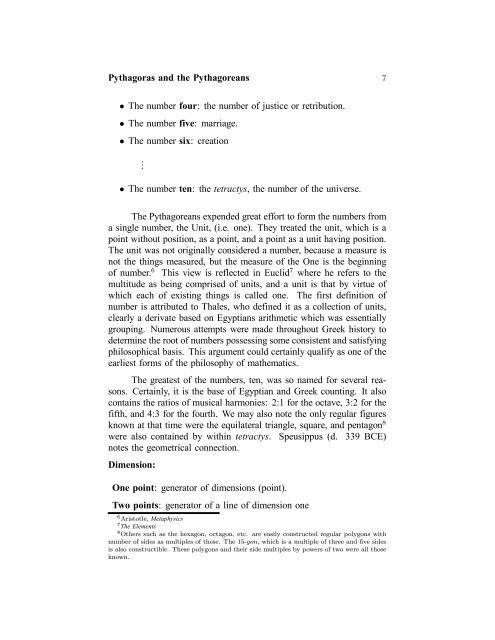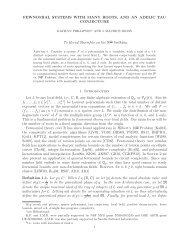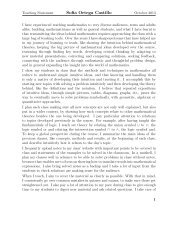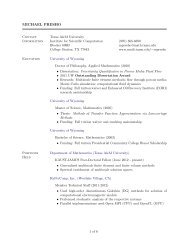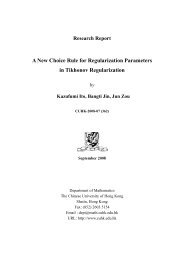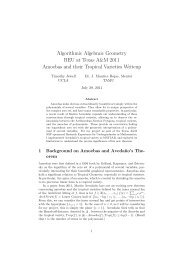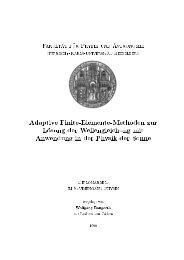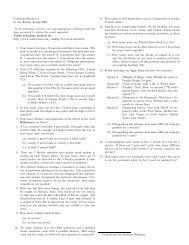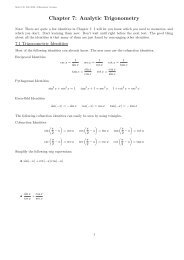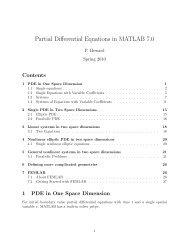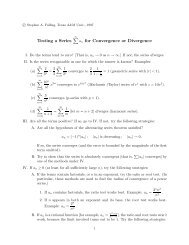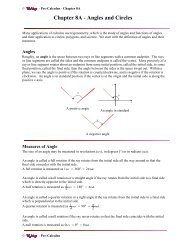Pythagoras and the Pythagoreans - Department of Mathematics
Pythagoras and the Pythagoreans - Department of Mathematics
Pythagoras and the Pythagoreans - Department of Mathematics
Create successful ePaper yourself
Turn your PDF publications into a flip-book with our unique Google optimized e-Paper software.
<strong>Pythagoras</strong> <strong>and</strong> <strong>the</strong> <strong>Pythagoreans</strong> 7<br />
• The number four: <strong>the</strong> number <strong>of</strong> justice or retribution.<br />
• The number five: marriage.<br />
• The number six: creation<br />
.<br />
• The number ten: <strong>the</strong>tetractys, <strong>the</strong> number <strong>of</strong> <strong>the</strong> universe.<br />
The <strong>Pythagoreans</strong> expended great effort to form <strong>the</strong> numbers from<br />
a single number, <strong>the</strong> Unit, (i.e. one). They treated <strong>the</strong> unit, which is a<br />
point without position, as a point, <strong>and</strong> a point as a unit having position.<br />
The unit was not originally considered a number, because a measure is<br />
not <strong>the</strong> things measured, but <strong>the</strong> measure <strong>of</strong> <strong>the</strong> One is <strong>the</strong> beginning<br />
<strong>of</strong> number. 6 This view is reflected in Euclid 7 whereherefersto<strong>the</strong><br />
multitude as being comprised <strong>of</strong> units, <strong>and</strong> a unit is that by virtue <strong>of</strong><br />
which each <strong>of</strong> existing things is called one. The first definition <strong>of</strong><br />
number is attributed to Thales, who defined it as a collection <strong>of</strong> units,<br />
clearly a derivate based on Egyptians arithmetic which was essentially<br />
grouping. Numerous attempts were made throughout Greek history to<br />
determine <strong>the</strong> root <strong>of</strong> numbers possessing some consistent <strong>and</strong> satisfying<br />
philosophical basis. This argument could certainly qualify as one <strong>of</strong> <strong>the</strong><br />
earliest forms <strong>of</strong> <strong>the</strong> philosophy <strong>of</strong> ma<strong>the</strong>matics.<br />
The greatest <strong>of</strong> <strong>the</strong> numbers, ten, was so named for several reasons.<br />
Certainly, it is <strong>the</strong> base <strong>of</strong> Egyptian <strong>and</strong> Greek counting. It also<br />
contains <strong>the</strong> ratios <strong>of</strong> musical harmonies: 2:1 for <strong>the</strong> octave, 3:2 for <strong>the</strong><br />
fifth, <strong>and</strong> 4:3 for <strong>the</strong> fourth. We may also note <strong>the</strong> only regular figures<br />
known at that time were <strong>the</strong> equilateral triangle, square, <strong>and</strong> pentagon 8<br />
were also contained by within tetractys. Speusippus (d. 339 BCE)<br />
notes <strong>the</strong> geometrical connection.<br />
Dimension:<br />
One point: generator <strong>of</strong> dimensions (point).<br />
Two points: generator <strong>of</strong> a line <strong>of</strong> dimension one<br />
6 Aristotle, Metaphysics<br />
7 The Elements<br />
8 O<strong>the</strong>rs such as <strong>the</strong> hexagon, octagon, etc. are easily constructed regular polygons with<br />
number <strong>of</strong> sides as multiples <strong>of</strong> <strong>the</strong>se. The 15-gon, which is a multiple <strong>of</strong> three <strong>and</strong> Þve sides<br />
is also constructible. These polygons <strong>and</strong> <strong>the</strong>ir side multiples by powers <strong>of</strong> two were all those<br />
known.


